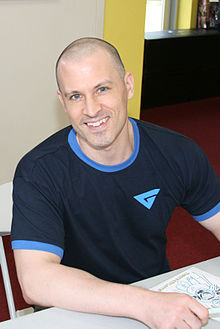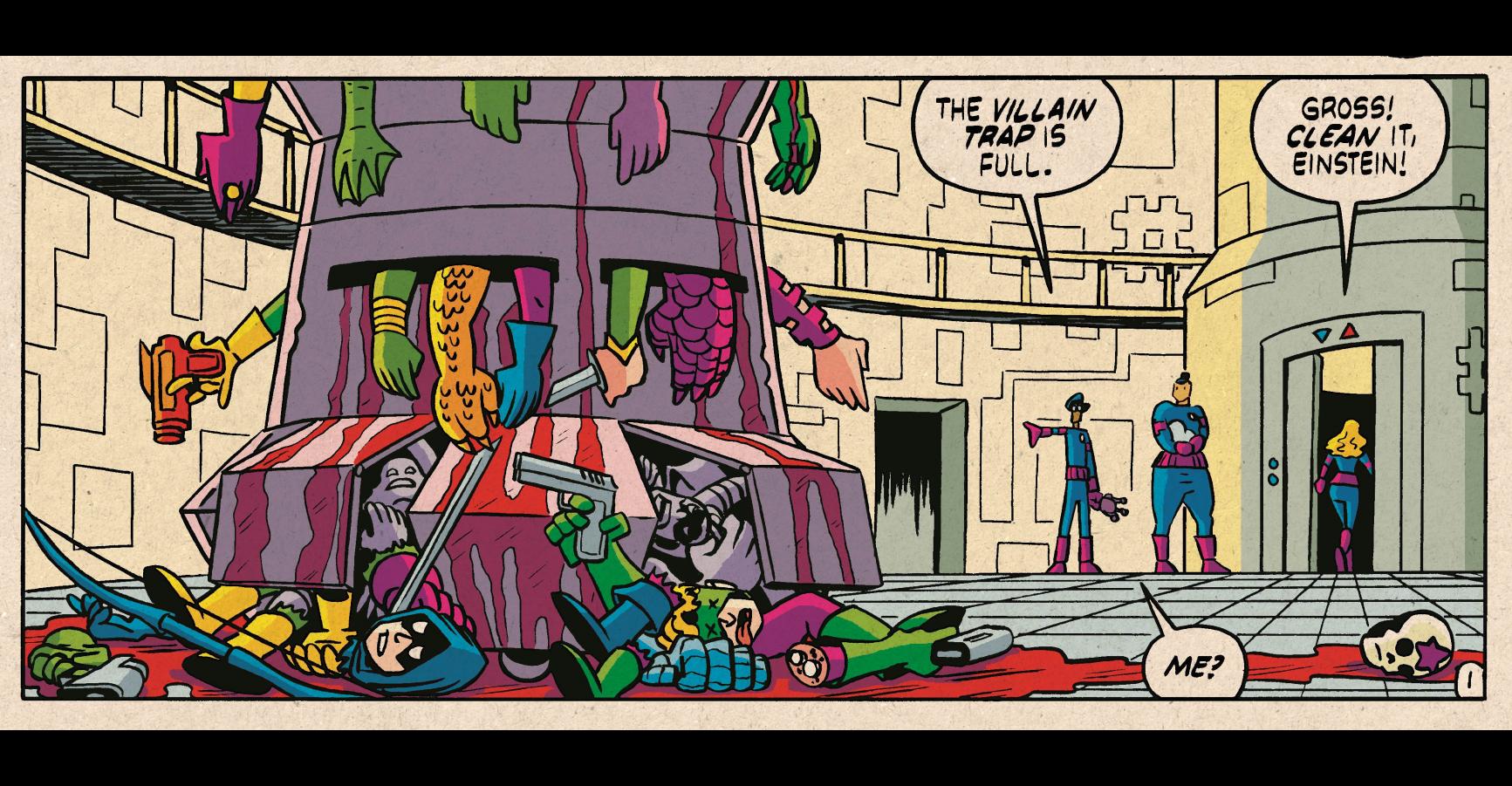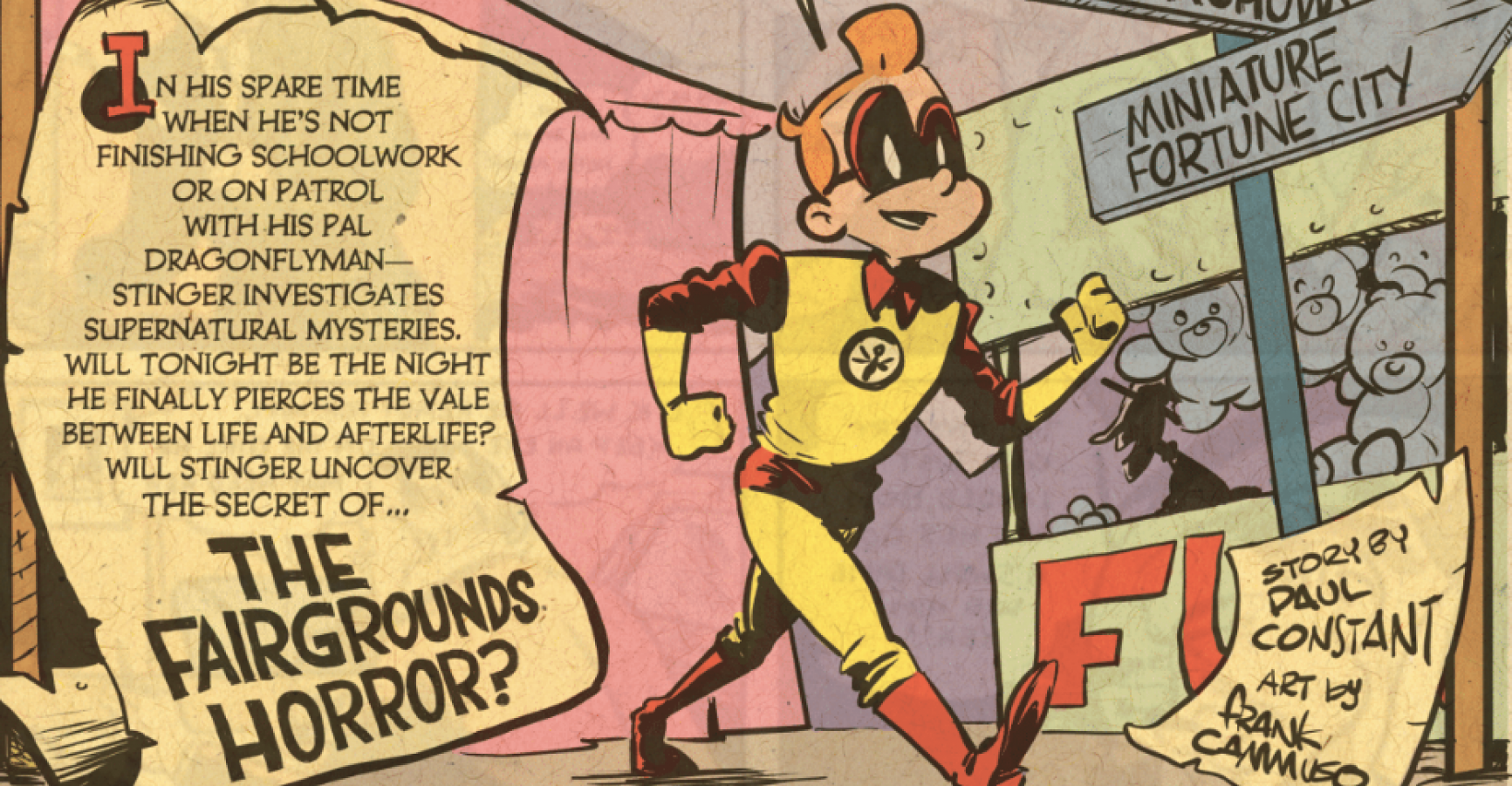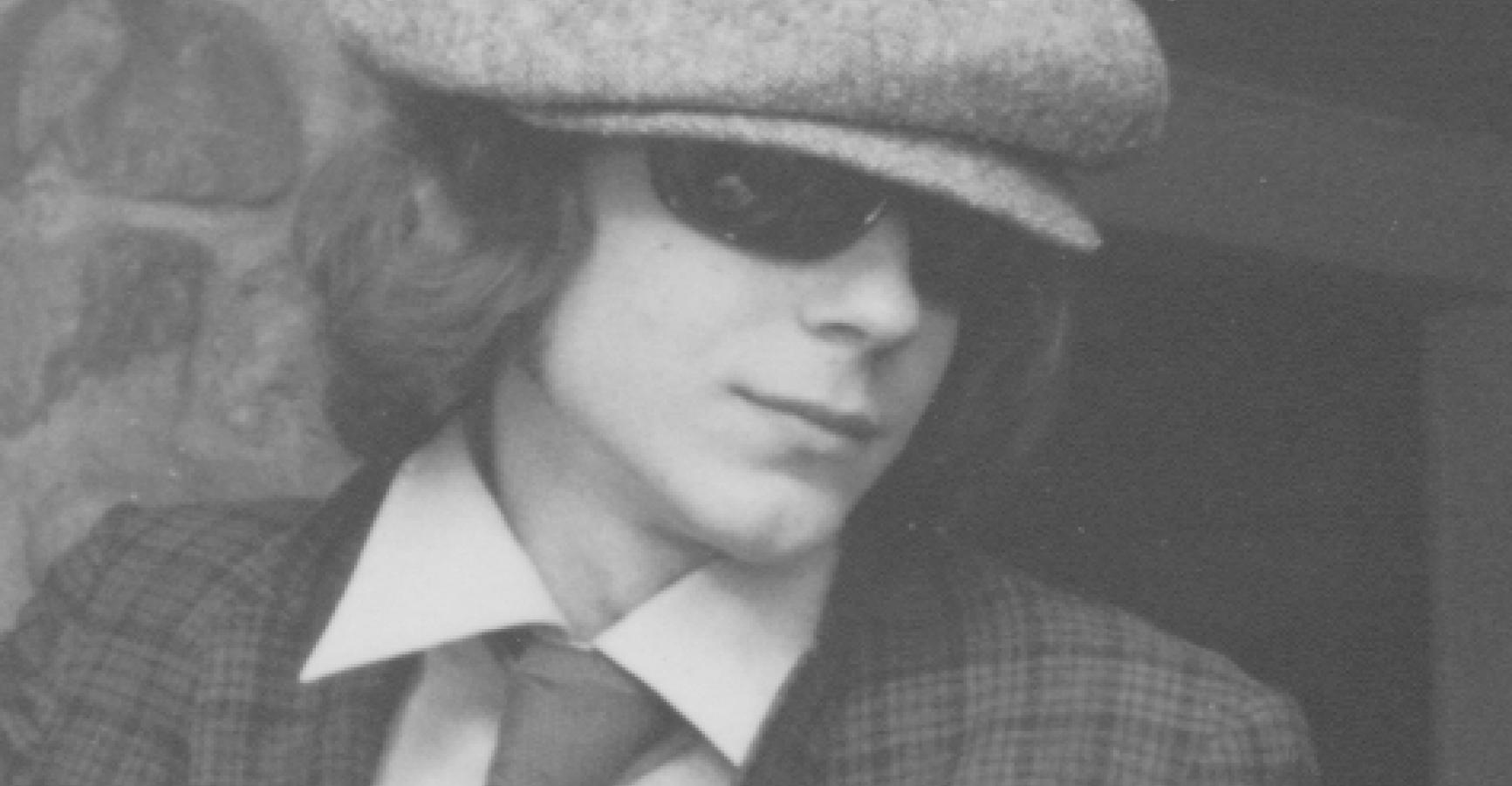For Chris Giarrusso, the creator of Mini-Marvels and G-Man, a longstanding career began with a college internship from the State University of New York at Binghamton. Giarrusso’s writing and art have won fans of both comic books and comic strips, and when AHOY Comics needed someone to draw HASHTAG: DANGER, its cartoony send-up of the superhero genre, the editors had only one person in mind.
From his North Carolina home, Giarrusso spoke with AHOY publisher Hart Seely, and talks commenced with a common subject: Syracuse, New York… the city that birthed both Giarrusso and AHOY.
Do you know Syracuse is currently (Note: early March) behind in the Golden Snowball race? We trail Buffalo by about 10 inches of snow.
I didn’t even know there was a race.
Every winter, the five upstate mega-cities—Buffalo, Rochester, Syracuse, Albany and Binghamton—battle to see who gets the most snow. Syracuse has won it 10 out of the last 11 winters. But this could be Buffalo’s year.
Huh. You know, after being away for about 10 years, I moved back to Syracuse in 2008. That year, the snow was just not the same as I remembered it. I mean, there were blizzards, but then everything melted, and you could see green grass. When I was growing up, once it started snowing, you never saw grass until springtime.
Why did you leave Syracuse? The weather, or lack of opportunity?
Lack of opportunity. Basically, out of college, I got a job working for Marvel, so I moved to New York City.
In your senior year at SUNY-Binghamton, you interned at Marvel. Ever meet Stan Lee?
Stan was living in California, but he came into the office one day, and I remember everybody being super-excited. It was, “STAN LEE’S HERE! STAN LEE’S HERE!” He was in the editor-in-chief's office. A crowd formed—everybody in production and editorial—with people jammed up into the hallway. Stan addressed everybody, talking about comics and whatever. I couldn’t get close enough to see him. I could barely hear him. That was our first crossing of paths.
A couple years later, I was on staff in the production department, and I happened to be in an elevator with him. He was talking with another guy, and it would not have been appropriate for me to go, “OH, MR. LEE!” So I just let it go. That’s my brush with glory: I was in the elevator with him.
I was once in an elevator with Adam Sandler. I pretended not to recognize him. He looked pissed.
I figure it’s just being courteous. I think famous people prefer that you just let them be.
There’s only a handful of people with whom I would lose it. Springsteen, for sure. Obama. An open lane to Trump. Anybody else, I’ll just look at my shoes.
I tend to jam up and get nervous. Even if it’s a person I should gush over, I’m likely to do nothing.
Back to interning: Is that when you came up with the idea for Mini-Marvels?
I didn’t think I’d ever have a shot at doing published work at Marvel. Until then, I’d been doing comic strips at my school paper. That was a step in the right direction, but my skills were not at the level where I could do a comic book. But what was in the realm of possibility was a comic strip.
I interned with Kelly Corvese, who did the What If…? comic books. Whenever we were sitting around, and if I thought it was appropriate, I’d pitch the dumbest What If…? ideas I could think of. And one time, he said, “You know what? If you want to make that into a comic strip, I’ll put it in the letters column.” So I did. A few of my strips appeared in the What If…? letters column, and when I came back a year later, some of the new assistant editors were like, “Oh, you’re that guy.” My friend Gregg Schigiel, and assistant editor at the time, suggested me to Zena Tsarfin, the Bullpen Bulletins editor, “If you want to fill space, have Giarrusso do a comic strip.” And the second or third idea for that strip was Mini-Marvels. I thought it was a gimmick I could ride forever. It was, “Look! Spider-Man as a kid!” Charles Schulz was my hero, so it was like a mash-up of Peanuts and Marvel characters.
How did you wrangle that internship? That’s a college student’s dream.
My brother called one day out of the blue and said, “Hey, Marvel’s got an internship program! You’ve gotta apply!” You were supposed to call a number, leave a message, and they’d call you back and set up an interview. I called the number, like, a million times. No one called back.
The following year, I tried again, and this time got a call. From what I’ve since learned, that first year was a chaotic time at Marvel, and they weren’t well organized. The next year, I got lucky.
You’ve said your older brother was one of your biggest influences. How did that happen?
He was my role model. He’s three years older than me, so everything he did, I was always right behind him, trying to do the same thing—much to his annoyance. That’s how I ended up in comics. He was reading comic strips in the newspaper, so I’d read them. He’d try and draw them, so I’d try and draw them. In that way, he was unwittingly my first art teacher.
If you hadn’t been an artist, what would you have done?
I don’t know. People would say, “You’re good at math, so you should be a math teacher or an accountant.” I guess I had a natural aptitude for math until I reached a point where I couldn't wrap my head around it anymore. Around the level of Calc-3, I was thinking, is this what I need to do to get the kind of job that people say I need? Is this how I’m going to work for the rest of my life… and be miserable? So I jumped ship. I looked at the art program and did the requisite courses – Drawing 101, Sculpture, whatever – and then got out of there. Then came the internship. That’s where the real education came—working at Marvel.
You do everything—write, draw, letter, everything. How do deal with the load?
That’s just how I’ve always done things. Traditionally, comic strips are cartoonier. And it’s faster to draw that way than it would be to deliver the more modern highly detailed realism, which takes more time and effort. My style and approach are less labor-intensive. On the other hand, other comic artists will pencil a page and move on to the next. I’ll pencil the page, then ink it, then do the lettering, and then the coloring.
That means a lot of time in the studio? How do deal with it?
Podcasts are a huge help, because if it gets really quiet, it becomes like, “Yeah, you’re going crazy.” TV shows are nice, but there’s a temptation to look up and stop drawing.
On a given day, how much time do you work?
Basically, all day. I’m trying to be more balanced, to get regular exercise, but usually what happens is, I’ll just think, “I’m a little behind today, so I’ll skip the gym and work late.” Some days just go from morning till night.
Do you have good days and bad days, or do they all even out?
Good and bad days. Some days, it feels like you can’t draw anything, and none of your ideas are any good. I’m wondering how I ever did this before, and if I can ever do it again. But you keep moving forward.
Self-doubt?
Yeah. All the time. Constantly. Part of it is the desire to be more successful and maybe the bar is just unrealistically high, so there's like a built-in guarantee I'll never feel good enough. I mean, I’m not about to be homeless or anything, but when I was in high school, back in the nineties, you would hear about guys making millions from comics, and that’s what you wanted. Years later, the market is completely different, and that kind of money is just not feasible. The dream was that, by now, I would be rich.(Laughs)
But you are successful. And you never know, maybe HASHTAG: DANGER will take off.
HASHTAG: DANGER is a lot of fun.
Of course, you must deal with Tom Peyer. Condolences. (Note: Seely and Peyer have been collaborators for 30 years.)
Working with Peyer is awesome. I don’t really work with writers that much. Usually I’m writing or co-writing the stuff I draw. But I really like working with Tom. His stories are great and I'm definitely in sync with his sense of humor. Also, it goes back to my brother, and growing up in Syracuse, because Tom is kind of a hometown hero.
Did you read his cartoons in the Syracuse New Times?
No, but my brother did, and when we talk, he always wants to hear about Tom. He remembers Bus Man and Little Ronnie and my uncle, also from the area, he says, “When you talk to Tom, tell him I want more Bat-Nun.” My brother remembers going to Dream Days (a legendary Syracuse comic book store), where Tom was there half the time, talking to Mike (the owner) about Reagan and stuff. There’s definitely a hometown hero aspect of it.
One of the things about working on my own stuff is that the only person I can disappoint is me. But now, working with Tom, I’m just thinking, “Man, I hope he likes it!”
You do a lot of comic conventions. What are the best and worst parts of that?
The best parts are people who say nice things, that they read your work and like it. The worst parts are the backhanded complements, like – this happened a lot when I was doing the Mini-Marvels—people would look at the books and assume I was going rogue, printing up my own bootleg comics without Marvel's permission. They’d ask, “How are you allowed to do this? Don’t you need permission?” Like it was inconceivable that Marvel would have hired me.
But nobody just comes up and berates you, right?
Only a couple times. Usually, the people that don’t like your stuff don’t bother to look for you. They’ll say it on social media or forums. But that guy won’t make me a priority at a convention.
People can be cruel.
The way I see it is that it happens to every creator, including the best. The more famous and successful you are, the more some people will try to tear it down.
Change of pace: Of all the superheroes, who would be the biggest asshole, up close?
Hmmm. I have to think on this. Norm MacDonald has a skit about Mr. Fantastic. He goes, “Hey, Sue, you turn invisible. So, you’re going to be called ‘the Invisible Woman.’ And Johnny, you are a human and a torch. So ‘Human Torch’ will be your name. Ben, you are a rock-like thing, so you will be ‘The Thing.’ And I can stretch myself like a rubber band. So, I will be… Mister Fantastic!”
(Laughing) I love Norm MacDonald. You ever see the YouTube video on Conan, where he goes off on some actress who’s just done a movie with Carrot Top?
Yes! The one where he says “B-O-R-E-D!” (Laughing)
Norm goes, “Carrot Top, eh? So what’s the name of the movie? Box Office Poison?” (Laughing)
She says, “It’s Chairman of the Board,” and Conan says, “Okay, Norm, try something with that.” And he says, “Board… spelled B-O-R-E-D.” (Laughing)
(Laughing) Okay, what were we talking about? Superhero assholes.
There’s got to be better answers.
A lot of people say Batman or Tony Stark.
Yes, I feel dumb for not mentioning them.
Okay, here’s another: Of all the supervillains, who’d be the nicest to work for?
Hmmm. Let’s see… you might like Doctor Doom, but I don’t think he’d be great to work for. The Red Skull? No. He wouldn’t be fun, unless you agreed with his ideology.
Nazis might like him. But good henchmen are hard to find. Some villains keep them a long time.
Well, the question is, can they leave? It could be that once you’re in with a villain, you’re in for life.
Yeah. Once you’re in with The Joker, you’re in with The Joker.
Yeah, and you never know when he’s going to poison you. He’d think it was hilarious. I bet his henchmen are too dumb to even think he’d do it to them.
The Joker’s henchmen have to not only be stupid, but incompetent. They constantly get beaten up by a guy with no super powers.
He must get the lowest quality guys. They have to be mentally challenged.
I like the old Batman villains who gave their henchmen colorful names.
They’d humanize them. As a reader, you became emotionally invested in that guy. When he dies, you’re like, “Oh, no, not Baldy!”
The Riddler would keep them laughing. The Penguin would pay well. So would Lex Luthor. He runs LexCorp.
Lex Luthor would be like working for Trump. You’d be like, “Hey, where’s my money?” He’d say, “Sorry, your henchmanship wasn’t up to our standards.”
-------------------------------------------------------------
Hey, mature readers! Click on the PDF link below for a preview of HASHTAG: DANGER #1! It's in stores May 1!

